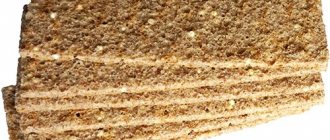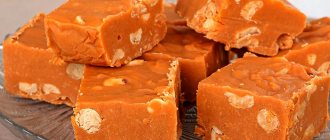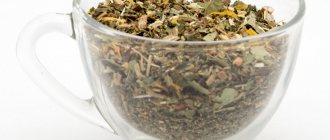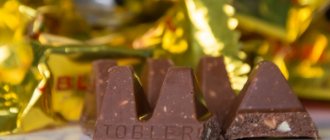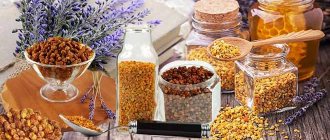General information
The sweetness is based on a substance consisting of nuts and seeds.
Previously, honey was added to halva, but now sugar is used instead. The crushed kernels are combined with caramel and special substances (for example, marshmallow) are added, giving the delicacy the desired shade, airiness and unique taste.
Calorie content and composition
The oriental delicacy contains:
- fiber and maltose;
- useful elements: copper, zinc, phosphorus, iron, etc.;
- vitamin C (activates collagen production);
- vitamin PP (regulates cholesterol);
- vitamin B1 (stabilizes pH in the body);
- vitamin D (normalizes metabolism, strengthens bones);
- vitamin E (removes toxins, accelerates the process of tissue regeneration).
Halva contains fiber and beneficial elements.
The number of kilocalories in a product depends on its type. For example, 100 g of sunflower sweetness contains about 500 kcal, almond sweetness – 497 kcal, sesame sweetness – 470 kcal. Dried fruits or chocolate icing can add calories to the treat.
Benefits of the product for weight loss
Often people on a diet are afraid to introduce cookies, candies and other sweets into their diet.
But in moderation, these products will not cause much harm to health, and giving them up will be stressful for the body. Since the oriental delicacy contains little sugar, nutritionists allow its use when losing weight, because. its other components have a beneficial effect on health. Sesame sweetness is recommended for the prevention of cancer; it also strengthens tendons. Almond – lowers blood cholesterol levels. Peanut has a positive effect on brain function. Tahini contains a high concentration of iron, which is good for preventing anemia.
Halva of any type strengthens the immune system, heals the liver and heart, and improves the condition of hair and skin.
Some doctors claim that the sweetness protects against cancer because it is prepared with cold-pressed oil. The product is useful for activating the reproductive system, because... it contains a lot of vitamin E.
Compound
There are several recipes for making halva. According to the oriental recipe, it contains only 4 components:
- sugar;
- saffron;
- warm oil;
- nuts.
In domestic countries, sunflower seeds are used to make halva, honey is used for consistency, and soap root is added.
Halva contains:
- vitamins (B1, B2, PP, E);
- potassium;
- sodium;
- magnesium;
- phosphorus;
- iron;
- zinc;
- calcium.
Thanks to such a rich composition, halva has a beneficial effect on human health.
Which halva is suitable for weight loss
Many manufacturers add dried fruits, chocolate or marmalade to halva. This increases the caloric content of sweets, so including such varieties in the diet is not recommended. There are several varieties of dessert, but only a few of them are allowed to be eaten while losing weight.
Sunflower
Sunflower halva is one of the most harmful varieties for your figure. A rich dessert can lead to weight gain rather than weight loss. Therefore, this type of sweet should not be consumed when eating on a diet. 100 g is enough to get 50% of your daily calorie intake.
Sunflower halva leads to excess weight gain.
Walnut
Peanut halva is prohibited for people with diabetes, since the product is high in calories and contains a large amount of sugar, which means there is a risk of gaining excess weight.
Despite the fact that the treat has a beneficial effect on brain function, it is better to postpone its consumption until the end of the diet. Almond halva has a low calorie content, but it facilitates physical activity. This sweetness is allowed for those who want to lose weight. Pistachio halva is considered an exotic product that is not widely used due to its high cost. At the same time, nutritionists note that this variety is most suitable for inclusion in the diet.
Sesame
Sesame delicacy can be tahini or natural. To prepare the latter, whole sesame seeds are used, the former is prepared from their kernels. They have the same calorie content, but tahini has a bitter taste. This halva improves the functioning of the cardiovascular system and lungs.
Sesame halwa has a bitter taste.
How much halva can you eat per day?
It’s quite difficult to name the exact norm, but you should understand that the product is not only high-calorie, but also quite fatty, so you definitely shouldn’t get carried away with it.
When answering the question whether you can gain weight from halva, you should take into account not healthy fats, but fast carbohydrates, which are also found in baked goods. The high energy value is also important, so yes, you can gain weight if you eat a large amount of the product daily.
The calorie content of a person's daily diet should be approximately 2500 kcal. This is the total calorie content of foods consumed during the day. Now let’s take the calorie content of halva and think about how much of it you can eat without gaining weight. Roughly speaking, half a kilo of halva gives us a daily caloric value, that is, 2500 kcal - accordingly, if you eat such an amount of sweetness, then you cannot eat anything else during the day. Although it is more likely that you will simply vomit from such an amount of a very sweet and quite fatty product. And if you have problems with sugar, you will have to inject a “horse” dose of insulin.
To make it easier, we divide the above daily calorie content into 3 meals. Although we do not consume the same amount of calories throughout the day, such division will help formulate an acceptable dose of halva. We get about 830 kcal. Now it’s worth considering that halva is a dessert - accordingly, about a third of the calorie content of one meal is allocated to it. As a result, it turns out that you can eat about 50 g of the product at a time without fear for your figure and general condition of the body.
How to eat properly
Halva should not be eaten at the same meal along with chocolate, cheese, dairy products and meat. This combination puts a lot of strain on the digestive system, and in people suffering from gastrointestinal diseases, it can cause heartburn, bloating, and nausea.
Daily norm
The recommended intake of halva is 30 g per day. Even on a diet, it is allowed to eat a small piece, provided that the rest of the food is light. For obesity and heavy weight, doctors advise limiting yourself to 50 g once a week.
Best time to consume
The best time to consume halva is before lunch.
It is not recommended to wash down dessert with a sweet drink; the ideal option is tea or freshly squeezed juice.
It is recommended to eat halva before lunch.
Advantages and disadvantages
| Advantages | Flaws |
|
|
Basic ways to lose weight
The halva diet is a good way to pamper yourself with sweets and at the same time lose weight. Including treats in the menu and replacing them with desserts, as well as using them as snacks, will reduce the calorie content of the diet. A person who is losing weight will saturate the body with useful substances and proteins of plant origin and receive a strong boost of energy.
Halva diet
Despite its unique composition (50% carbohydrates, the rest proteins and fats), most doctors are skeptical about a mono-diet based on oriental sweets.
After all, you only need to consume halva - 200 g per day, you need to eat a small piece several times a day, washed down with green tea. This amount of sweetness is enough to 100% cover the daily calorie requirement for an adult (1000–1100 kcal). But you cannot stick to this diet for more than 3-5 days.
Such an express diet will help you get rid of 3-4 kg, but it is contraindicated for people with diabetes and those who are prone to obesity.
Fully or partially limited products
For 3-5 days it is recommended to completely exclude from the diet:
- sugar, salt, spices;
- meat, cereals, bakery products, sausages;
- fatty cheeses, chocolate, cakes;
- high-calorie foods - roasts, borscht, mashed potatoes, cutlets, julienne, Olivier salad and other snacks;
- alcohol.
Table of prohibited products
| Proteins, g | Fats, g | Carbohydrates, g | Calories, kcal | |
Vegetables and greens | ||||
| canned eggplants | 0,9 | 0,7 | 7,3 | 49 |
| sauerkraut | 1,8 | 0,1 | 4,4 | 19 |
| potato | 2,0 | 0,4 | 18,1 | 80 |
| canned cucumbers | 2,8 | 0,0 | 1,3 | 16 |
| salted tomatoes | 1,1 | 0,1 | 1,6 | 13 |
Cereals and porridges | ||||
| porridge | 3,3 | 1,2 | 22,1 | 102 |
Flour and pasta | ||||
| pasta | 10,4 | 1,1 | 69,7 | 337 |
| spaghetti | 10,4 | 1,1 | 71,5 | 344 |
| paste | 10,0 | 1,1 | 71,5 | 344 |
| vareniki | 7,6 | 2,3 | 18,7 | 155 |
| dumplings | 11,9 | 12,4 | 29,0 | 275 |
Bakery products | ||||
| loaf | 7,5 | 2,9 | 50,9 | 264 |
| buns | 7,2 | 6,2 | 51,0 | 317 |
| donuts | 5,8 | 3,9 | 41,9 | 215 |
| crackers | 11,2 | 1,4 | 72,2 | 331 |
| bread | 7,5 | 2,1 | 46,4 | 227 |
Confectionery | ||||
| jam | 0,3 | 0,2 | 63,0 | 263 |
| jam | 0,3 | 0,1 | 56,0 | 238 |
| candies | 4,3 | 19,8 | 67,5 | 453 |
| ready-made sponge cakes | 5,9 | 0,8 | 56,3 | 258 |
| cookie | 7,5 | 11,8 | 74,9 | 417 |
Raw materials and seasonings | ||||
| honey | 0,8 | 0,0 | 81,5 | 329 |
| sugar | 0,0 | 0,0 | 99,7 | 398 |
| salt | 0,0 | 0,0 | 0,0 | — |
| fructose | 0,0 | 0,0 | 99,8 | 399 |
Meat products | ||||
| pork | 16,0 | 21,6 | 0,0 | 259 |
| salo | 2,4 | 89,0 | 0,0 | 797 |
| beef | 18,9 | 19,4 | 0,0 | 187 |
| bacon | 23,0 | 45,0 | 0,0 | 500 |
| ham | 22,6 | 20,9 | 0,0 | 279 |
Sausages | ||||
| boiled sausage | 13,7 | 22,8 | 0,0 | 260 |
| Smoked Minsk sausage | 23,0 | 17,4 | 2,7 | 259 |
| smoked Moscow sausage | 24,8 | 41,5 | 0,0 | 473 |
| sausages | 10,1 | 31,6 | 1,9 | 332 |
| sausages | 12,3 | 25,3 | 0,0 | 277 |
Oils and fats | ||||
| butter | 0,5 | 82,5 | 0,8 | 748 |
| creamy margarine | 0,5 | 82,0 | 0,0 | 745 |
| animal fat | 0,0 | 99,7 | 0,0 | 897 |
Alcoholic drinks | ||||
| white wine Muscat | 0,0 | 0,0 | 5,0 | 82 |
| vodka | 0,0 | 0,0 | 0,1 | 235 |
| liquor | 0,3 | 1,1 | 17,2 | 242 |
| beer | 0,3 | 0,0 | 4,6 | 42 |
| champagne | 0,2 | 0,0 | 5,0 | 88 |
| * data is per 100 g of product | ||||
Homemade halva recipes
This oriental delicacy can be prepared at home, because... The manufacturing technology is simple and does not require a large number of ingredients.
From walnuts
The fastest and easiest way to create “Uzbek” halva is from walnuts.
Walnut halva is quick to prepare.
Required components:
- sugar – 200 g;
- milk – 0.5 l;
- flour – 130 g;
- peeled nuts - ½ tbsp.;
- ghee – 130 g.
Pour milk into a small saucepan, add sugar, mix thoroughly and bring to a boil.
In another container over medium heat, melt the butter and add the sifted flour. Fry until the mixture turns a soft cream color. Pour the milk syrup into the flour in a thin stream, stirring constantly so that no lumps form. Fry for 20 minutes, cool. Grind the nuts, add to the milk-flour mixture, form into small balls. Roll the preparations in pre-roasted sesame seeds.
With dates
There is a way to make a completely vegan version of halva. The recipe contains only plant ingredients and, in addition, there is no sugar. The basis of the dish is dates and sunflower seeds. This dessert is good not only for those who avoid animal products, but also for children, since it does not contain any components that are harmful to health.
Composition of ingredients
For cooking, you should prepare products according to the following list:
- 50 g dates;
- 2 tbsp. l. water;
- 150 g pre-hulled sunflower seeds.
This quantity of products is designed for 4 servings of the dish.
Dates can be completely replaced with sweet varieties of dried apricots, but in this case the halva will have a sour, fruity taste.
Step-by-step cooking process
The technology for preparing this type of halva is slightly different from the others:
- Dates are poured with boiling water and left for 30 minutes.
- Remove the bones.
- Sunflower seeds are ground with a blender or coffee grinder.
- Add dates and water.
- Grind the mixture again with a blender and mix thoroughly.
- Spread the resulting mass into the mold and lightly compact it.
- Place the container in the freezer for 30 minutes.
After half an hour, the finished halva can be removed and cut into pieces of any shape.
What can I add?
If desired, you can add cocoa powder, vanillin or vanilla, cinnamon or additional dried fruits, such as dried apricots or sweet raisins, to the dish.
How to serve a dish
This type of halva is served the same way as all the others - with hot unsweetened drinks, cut into small pieces.
Before serving, the dish can be decorated with a sprinkle of chopped nuts or sesame seeds.
Rules for selection and storage
The shelf life of homemade and store-bought halva varies. In 90% of cases, the label indicates a period of up to six months. After opening, the product must be kept in the refrigerator. In stores, halva is sold in foil packaging; at home, it is better to transfer it to a container with a tight lid. A homemade delicacy can be placed in a glass container. You should not wrap sweets in cling film; due to contact with air, it will lose most of its vitamins.
Halva must be hermetically sealed.
When choosing a product, you need to pay attention to the following nuances:
- packaging must be sealed;
- no caramel veins;
- the cut is smooth;
- when cut, the halva retains its shape and does not crumble into crumbs;
- if drops of oil are visible on the surface, it means that the cooking technology was violated and it is better to refrain from purchasing such a product.
How to choose a quality product?
When buying halva, it is important to pay attention to its appearance. A high-quality and fresh product does not have greasy stains on the surface. When purchasing dessert in packaging, you need to familiarize yourself with the composition, as well as the expiration date. The product in bulk is not stored for so long, which must be taken into account when purchasing. The shelf life of halva under a layer of cardboard is no more than 2 months.
Modern manufacturers often add all sorts of additives to halva, which improve the taste of the product and increase its shelf life. Such additives include sweeteners, GMOs, dyes, and preservatives. If they are present in the composition, you should not expect exceptional benefits from halva. Harmful additives do not have the most favorable effect on human health.
Harm and contraindications
Due to the high concentration of sugar in the composition, halva should not become a daily part of the diet.
The product must be consumed in limited quantities. Experts do not recommend giving oriental sweets to children under 2 years of age, because... their body is sensitive to changes in sugar levels. A regular increase in this indicator becomes one of the reasons for the development of diabetes in the future. School-age children can be given 10-15 g 2-3 times a week. Halva can harm the body if you ignore the recommendations of specialists and consume it in unlimited quantities. There is always a risk of purchasing an expired product or one prepared in violation of technology. Sweetness sometimes causes severe intoxication, because... the presence of nuts and seeds increases the concentration of cadmium in the body.
Some manufacturers, in pursuit of profit, use artificial additives and dyes that may contain harmful substances, so you need to buy the product only in trusted places.
Halva should not be eaten if you have problems with the gastrointestinal tract.
Since halva is considered a heavy food, it should not be included in the diet if you have problems with the gastrointestinal tract. Especially for gastritis, pancreatitis and stomach ulcers. The product is contraindicated for those with nut intolerance.
Composition and nutritional value of the product
The basis of halva is a ground substance from seeds or nuts. It was once prepared by mixing it with honey. Nowadays honey is replaced with sugar. Crushed kernels of seeds or nuts are mixed with caramel and special substances are added to make it light and airy. May also include:
- chocolate;
- powdered milk;
- quiche-mish;
- marmalade;
- cocoa powder;
- coconut flakes.
The most popular sweet made from sunflower seeds contains 11.6 g of proteins, 29.7 g of fat, and 54 g of carbohydrates per 100 g.
Interesting! Asteroid No. 518 is named after this ancient oriental dessert. Raymond Dugan, who discovered it, adored this delicacy.
What are they made from?
Halva is made from various seeds and nuts. And so there are types such as:
- sunflower;
- peanut;
- almond;
- tahini (from sesame paste);
- pistachio;
- sesame
More often the protein base is mixed with sugar. But there is also honey halva. It is higher in calories, but also more healthy.
Important! It is better to buy halva in sealed packaging. When interacting with air, caramel quickly oxidizes and darkens, and halva loses its airy structure. In addition, a delicacy packaged in this way is better protected from the entry and proliferation of pathogenic organisms, including E. coli and Staphylococcus aureus, which cause severe food poisoning, than a product sold by weight. Good quality halva crumbles perfectly and does not stick to the teeth.
Traditionally, halva is not cut, but pricked. At the same time, it forms pieces, on the cut of which you can clearly see the structure of the product. The tradition of stabbing the delicacy came from the East, when they checked the quality of the product in this way. However, today this tradition is often forgotten in favor of the convenience of chopping halva, because cutting it is much more convenient if you have knives of the necessary sharpness and size.
Calorie content
The energy content of the oriental sweet made from sunflower seeds is 500-523 kcal per 100 g. The least high-calorie types of halva are made from pistachios and sesame - these are 497 and 470 kcal, respectively. The highest calorie is almond, it contains 550 kcal. Tahini – 510 kcal. The inclusion of dried fruits or chocolate glaze can add calories. In addition, due to its high iron content, it can be recommended to those people who have a lack of iron in their bodies, for example, those who already suffer from iron deficiency anemia, and pregnant women, because the child’s body actively absorbs iron from the mother’s body for development.
Benefits and harms
The oriental dessert is very nutritious and rich in nutrients. Halva contains vitamins B, E, and D in abundance. Sesame halva prevents cancerous tumors in the gastrointestinal tract, strengthens bones and tendons. Almond helps reduce cholesterol. Peanut activates brain activity. Tahini contains a lot of iron and is good for preventing anemia.
Expert opinion
Evgeniy Kislitsa
Practicing surgeon. Certified massage master. Two-time vice-champion and heavyweight champion of regional kettlebell lifting competitions.
Due to the significant content of vitamins B, E, D in halva, it not only improves health, but also prevents the development of dangerous diseases, including even malignant neoplasms (relatively speaking, cancer). B vitamins are necessary for the normal functioning of the nervous system (especially the brain), liver, pancreas, adrenal glands, maintaining a normal immune response when foreign agents (bacteria, viruses, fungi) enter the body. With a lack of this substance, pathologies of the above organs develop and the immune system weakens. This can be avoided by eating foods rich in vitamin B in sufficient quantities. Vitamin D is necessary for the normal course of calcium metabolism in the body. This mineral is primarily necessary for maintaining the strength of bones and cartilage, the normal course of their growth processes (especially important for children) and recovery. With a deficiency of vitamin D, children may develop rickets and problems with mental development, and in adults, intellectual performance decreases and the risk of bone fractures increases sharply, which are very difficult to restore their structure or may not be restored at all. Therefore, sufficient consumption of foods containing vitamin D helps prevent these diseases and pathologies. This is especially true for those people who are little exposed to sunlight due to work or lifestyle, because a significant proportion of vitamin D is formed in the skin under the influence of solar radiation. Vitamin E is a natural antioxidant - a substance that prevents the processes of lipid peroxidation, during which peroxides are formed that destroy the structure of any cells and lead to the formation of mutations in cell genes. Mutant cells are able to transmit abnormal genetic information to their descendants (the same mutant cells are formed) and multiply uncontrollably (like their descendants). As a result, huge populations of mutant cells are formed, which lead to the formation of a malignant tumor (cancer). A sufficient supply of vitamin E from outside, which halva is rich in, can reduce the likelihood of the formation of malignant tumors.
Halva of any kind:
- strengthens the immune system;
- helps improve the appearance of hair, skin, nails, eyebrows and eyelashes, helps strengthen bones, cartilage, and accelerate tissue restoration processes in joints;
- prevents the development of diseases of the liver, cardiovascular and nervous system;
- allows you to resist stress, prevents the development of neuroses and psychoses, and improves mental performance.
Oriental sweetness is especially useful for those who have ailments such as:
- heart failure;
- cardiac ischemia;
- a life-threatening hypoglycemic condition that develops during prolonged fasting and in people suffering from diabetes (often develops when an excessive dose of insulin is administered), especially if the blood glucose level drops to critical levels - just eat a piece of halva to raise the blood sugar level;
- thrombosis of blood vessels, which is very dangerous if there are blood clots in the arteries, especially in those that supply blood to the heart - consuming halva reduces the risk of blood clots, the likelihood of their increasing in size (a large thrombus can completely block the vessel) or breaking off and migrating along the bloodstream with subsequent blockage of the blood vessel;
- prevent the formation of atherosclerotic plaques on arterial vessels by lowering cholesterol levels and the spread of existing atherosclerotic changes further along the vessel or their transfer to other vessels;
- deficiency of serotonin (pleasure hormone), due to the lack of which mental disorders of varying severity are observed, including severe depression.
Some experts also believe that halva prevents cancer, as it is created on the basis of cold-pressed oil. It is useful for almost everyone to enhance the production of sex hormones, thereby increasing sexual desire and function, and the likelihood of pregnancy. This is because oriental sweetness is rich in vitamin E.
But due to the high sugar content, this dessert should not be a daily dish on the table. It should be used very moderately. In general, it is not advisable to give halva to children under 2 years of age; their body is very sensitive to changes in the level of sugar (of which halva is rich) in the blood, a frequent significant increase in which can become one of the reasons for the development of diabetes in the future. For older children, nutritionists advise giving no more than 10-15 g of halva two to three times a week.
Being a heavy food, oriental sweetness is undesirable for those who have gastrointestinal disorders. Especially if there is an enzyme deficiency or inflammatory diseases in the acute phase of their course, for example, gastritis, peptic ulcer, colitis. It is better not to consume this delicacy at night, or on an empty stomach. Otherwise, even a healthy person may experience digestive problems.
Important! Halva is contraindicated for those who are allergic to nuts, sunflower seeds, sesame, diabetes (especially if the patient takes insulin), pancreatitis, gastritis or peptic ulcer of the stomach or duodenum, colitis in the acute phase of their course.
Is this a dietary product or not?
Fructose halva fits into a diet for diabetics. The dietary product should not contain any chemical ingredients. It should contain:
- sunflower seeds (or nuts);
- fructose;
- milk serum;
- liquorice root.
If your goal is to lose weight, you shouldn’t get carried away with halva. Even fructose sweets, which are allowed for people with diabetes, have an energy value of 520 kcal per 100 g of product.
You may also be interested in: Is it possible to eat dark chocolate on a diet?
Be sure to check out:
Is it possible to eat corn while on a diet: benefits and harms? Get a complete set of proteins, fats and carbohydrates from Doshirak dietary products on a diet: is it possible to eat fast food products? Is it possible to eat soy sauce while on a diet: all the myths and truth
Nutritionist opinion
Anna Chaikina, nutritionist
I recommend using halva for intellectual and psycho-emotional stress. It helps replenish sugar deficiency during increased mental stress. It is useful to introduce sweets into the diet not only for those losing weight, but also for children during the school year. But you need to eat no more than 30 g per day.
Elena Malysheva, doctor and TV presenter
Halva normalizes metabolism, reduces cholesterol, and prevents the formation of atherosclerotic plaques in blood vessels. But we must not forget that the delicacy contains 50% of the daily calorie requirement. When purchasing a product, make sure that there are no drops of fat on the surface. The sticky halva indicates that it contains a lot of caramel. And this is harmful.
Tikhomirov Sergey, fitness trainer
Halva allows you to quickly recover after physical activity and energizes you for the day. Those who are constantly involved in sports can eat oriental sweets without fear; the extra kilocalories will be burned during training.
Reviews and results
- Christina: “...I recently found out that you can quickly lose a few extra pounds with halva and hibiscus. It’s a very tasty and healthy combination, I liked it, and you can eat it as much as you want, whenever you want. I maintained this diet habits for 7 days and lost 3.5 kg! At the same time, the figure has become significantly slimmer, and most importantly, the waist size has decreased.”
- Irina: “... How I suffered on different diets, where I really want sweets, but I can’t! A friend advised me to eat halva in small portions and it turned out that it was much easier to lose weight. “I eat 30 g of halva with lemon balm tea in the evening and for six months now I have not gained extra pounds, and my mood and health have improved.”
- Alena: “... I can eat oriental sweets all day long, I always bring them back from vacation and arrange such fasting days for myself. You can painlessly remove an extra kilogram in a day.”
Useful tips
Halva is an allergenic product; you should not eat it on an empty stomach.
Also, you should not eat sweets after a heavy lunch or dinner, otherwise there is a risk of overloading the digestive system. It is not recommended to purchase halva on the market, because... storage rules are often not followed there and there is a risk of purchasing damaged goods. It is necessary to follow the rules for maintaining the dessert so that mold does not form on the surface. If possible, try the product before purchasing. Fresh sweetness quickly dissolves in the mouth and has a pleasant aroma.
If the dessert is made with fructose, diabetics can afford it, but in small quantities. After removal of the gallbladder or exacerbation of chronic cholecystitis, halva is allowed to be eaten only 1.5 months after surgery.
During pregnancy and lactation
Future and current mothers should be very careful when choosing products so as not to harm themselves, much less the health of the child. When choosing halva, the main thing is to study the composition and make sure that it does not contain antioxidants , preservatives , dyes , flavors , or flavor enhancers . Also, remember:
- do not take wet halva, especially if fat “flows” from it;
- give preference to tahini and pistachio desserts rather than peanut ones, because they are the ones that can most often provoke allergic reactions ;
- don’t attack right away, but check whether you are specifically allergic to this product, and best of all, first consult your family doctor.
Attention!
Of course, mono-diets are absolutely not suitable for nursing mothers or pregnant women; you can only eat halva for dessert, in small quantities (no more than 30 g) to diversify your diet and enjoy the beneficial properties of this oriental sweetness!





